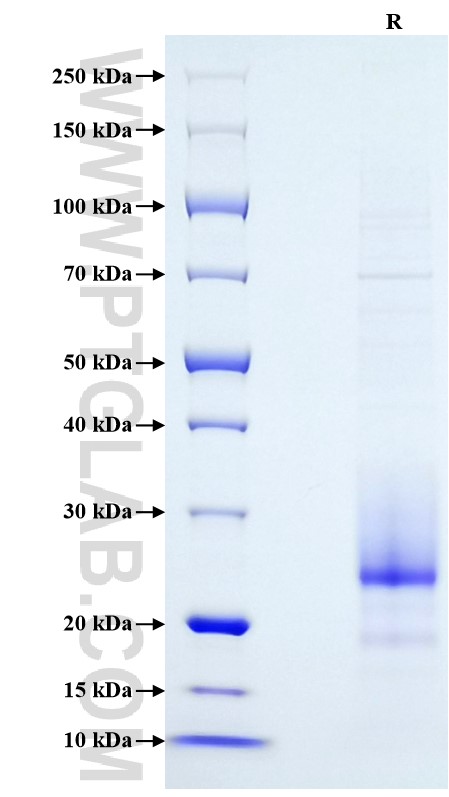Recombinant Human VEGF-C protein (Myc Tag, His Tag)
种属
Human
纯度
>90 %, SDS-PAGE
标签
Myc Tag, His Tag
生物活性
未测试
验证数据展示
产品信息
| 纯度 | >90 %, SDS-PAGE |
| 内毒素 | <0.1 EU/μg protein, LAL method |
| 生物活性 | Not tested |
| 来源 | HEK293-derived Human VEGF-C protein Thr103-Arg227 (Accession# P49767) with a Myc tag and a His tag at the C-terminus. |
| 基因ID | 7424 |
| 蛋白编号 | P49767 |
| 预测分子量 | 19.1 kDa |
| SDS-PAGE | 24-25 kDa, reducing (R) conditions |
| 组分 | Lyophilized from 0.22 μm filtered solution in PBS, pH 7.4. Normally 5% trehalose and 5% mannitol are added as protectants before lyophilization. |
| 复溶 | Briefly centrifuge the tube before opening. Reconstitute at 0.1-0.5 mg/mL in sterile water. |
| 储存条件 |
It is recommended that the protein be aliquoted for optimal storage. Avoid repeated freeze-thaw cycles.
|
| 运输条件 | The product is shipped at ambient temperature. Upon receipt, store it immediately at the recommended temperature. |
背景信息
Vascular endothelial growth factor C (VEGF-C) is a protein that is a member of the platelet-derived growth factor / vascular endothelial growth factor (PDGF/VEGF) family. The main function of VEGF-C is to promote the growth of lymphatic vessels (lymphangiogenesis). It acts on lymphatic endothelial cells (LECs) primarily via its receptor VEGFR-3 promoting survival, growth and migration. Apart from vascular targets, VEGF-C is also important for neural development and blood pressure regulation.
参考文献:
1. V Joukov. et al. (1996) EMBO J. 1996 Jan 15;15(2):290-98. 2. Barbara Le Bras. et al. (2006) Nat Neurosci. Mar;9(3):340-8. 3. Agnes Machnik. et al. (2009) Nat Med. 15(5):545-52.
